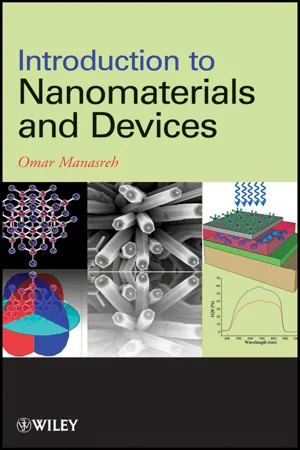
- English
- ePUB (mobile friendly)
- Available on iOS & Android
Introduction to Nanomaterials and Devices
About This Book
An invaluable introduction to nanomaterials and their applications
Offering the unique approach of applying traditional physics concepts to explain new phenomena, Introduction to Nanomaterials and Devices provides readers with a solid foundation on the subject of quantum mechanics and introduces the basic concepts of nanomaterials and the devices fabricated from them. Discussion begins with the basis for understanding the basic properties of semiconductors and gradually evolves to cover quantum structures—including single, multiple, and quantum wells—and the properties of nanomaterial systems, such as quantum wires and dots.
Written by a renowned specialist in the field, this book features:
-
An introduction to the growth of bulk semiconductors, semiconductor thin films, and semiconductor nanomaterials
-
Information on the application of quantum mechanics to nanomaterial structures and quantum transport
-
Extensive coverage of Maxwell-Boltzmann, Fermi-Dirac, and Bose-Einstein stastistics
-
An in-depth look at optical, electrical, and transport properties
-
Coverage of electronic devices and optoelectronic devices
-
Calculations of the energy levels in periodic potentials, quantum wells, and quantum dots
Introduction to Nanomaterials and Devices provides essential groundwork for understanding the behavior and growth of nanomaterials and is a valuable resource for students and practitioners in a field full of possibilities for innovation and invention.
Frequently asked questions
Information
Table of contents
- Cover
- Title Page
- Copyright
- Dedication Page
- Preface
- Fundamental Constants
- Chapter 1: Growth of Bulk, Thin Films, and Nanomaterials
- Chapter 2: Application of Quantum Mechanics to Nanomaterial Structures
- Chapter 3: Density of States in Semiconductor Materials
- Chapter 4: Optical Properties
- Chapter 5: Electrical and Transport Properties
- Chapter 6: Electronic Devices
- Chapter 7: Optoelectronic Devices
- Appendix A: Derivation of Heisenberg Uncertainty Principle
- Appendix B: Perturbation
- Appendix C: Angular Momentum
- Appendix D: Wentzel-Kramers-Brillouin (WKB) Approximation
- Appendix E: Parabolic Potential Well
- Appendix F: Transmission Coefficient in Superlattices
- Appendix G: Lattice Vibrations and Phonons
- Appendix H: Tunneling Through Potential Barriers
- Index